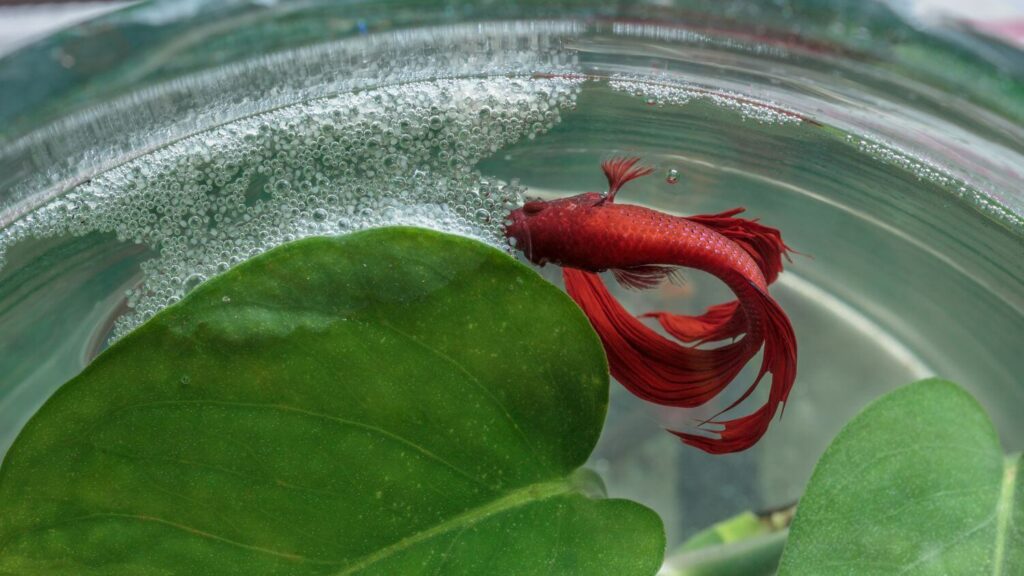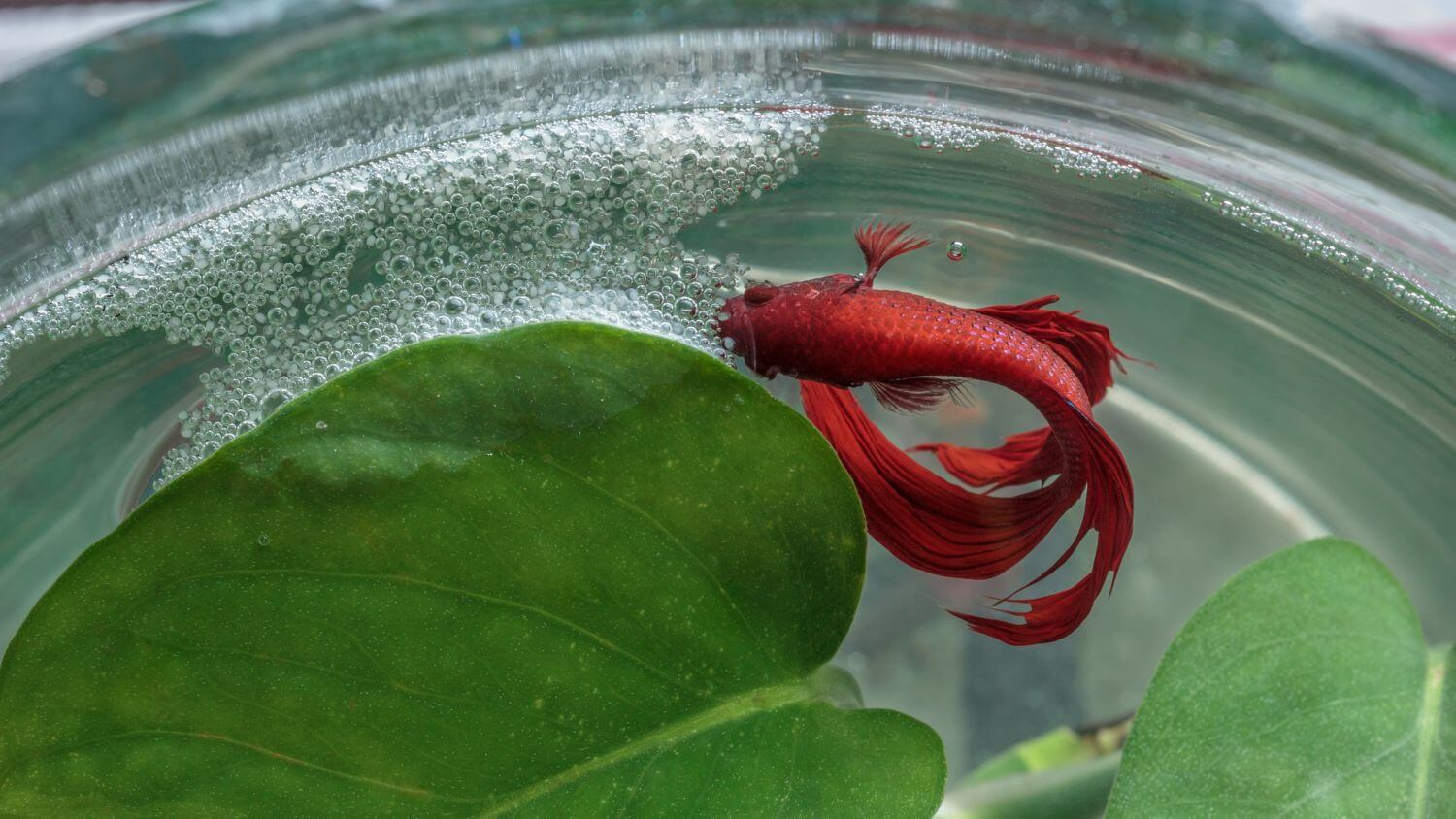Betta bubble nests are a spectacular sight to see—and if your betta is currently building one, consider yourself lucky. You now get the opportunity to watch as your fish does something unique to bubble-nest making fish, such as betta fish.
But why do bettas create bubble nests? What is the purpose of a betta fish bubble nest? And worse, can a bubble nest also be a sign of sickness in your fish?
We’re going over everything you need to be aware if your male betta fish starts making a bubble nest. Let’s dive in.
What is a betta bubble nest?

Bubble nests are small bubbles, and bettas make these nests around the floating plants or on the sides of the aquarium sides. Bubble nests can be of any size and form.
Usually, these nests look foamy, but some may have a clear bubble shape with lots of air inside. If you see white foamy substances floating on the tank top, it’s nothing other than a bubble nest.
New aquarists who aren’t aware of how bubble nests look may find it alarming and might panic, but rest-assured, there is nothing to worry about.
Bubble nests are very delicate; hence the tank water should have very low currents for the nest to remain safe. Also, the tank water should be clean and free from floating debris; otherwise, the nest will be torn apart.
Interestingly, not all types of betta fish make bubble nests. Betta varieties like Betta Splendens make bubble nests, but some wild betta species like Betta Simplex or Krabi Mouth-Brooding Betta do not.
Why do male betta fish build nests?
Mating
The bubble nest is mainly built by the male betta fish. It’s a sign that the fish is ready to mate and is attracting the female betta fish. When a male betta fish is ready to mate, they begin building a nest for the eggs.
Bubble nests are mainly to keep the betta eggs after they mate. The male betta keeps them in the bubble nest and protects them till the eggs hatch.
Ideal tank environment
But other times, it’s a sign of a happy betta. When your betta fish begins building a nest, it’s an indication that they are happy in their home. Bettas are very particular about their surroundings, and as such, you can feel confident knowing your betta is thriving when they start building a nest.
What to do when your male betta fish doesn’t build a bubble nest
Sometimes the male betta may not build bubble nests naturally. In order to trigger this response, you can introduce a female betta fish.
The male betta will start the bubble nest building within 24 hours of introducing the female fish. If the female does not reciprocate, the male betta destroys the nest and starts the process all over again.
To help your betta fish make bubble nests, try to increase humidity in the tank. You can do so by placing a plastic film over the tank to increase the humidity. Adding live plants like Indian almond leaves will also encourage your male betta to build a bubble nest.
Betta fish behavior during bubble best building
We know that male betta fishes are very aggressive and they cannot stand any other fish in their tank. But when male bettas build a bubble nest, they tend to become timid.
The male fish spends more time under the bubble nest waiting for the female betta. When the female betta enters the tank, it tries to attract her by flashing its colorful fins and gills.
The male fish then chases the female betta and nips at her. Sometimes nipping may get dangerous if the situation gets aggressive.
They mate under the bubble nest, and the female betta lays eggs on the aquarium’s bottom. You should immediately remove female bettas from the tank once mating is complete, as the male betta fish gets extremely aggressive after the spawning process and may attack female bettas.
After that, the male betta collects the fertilized eggs and places them in the betta bubble nest. For the next few days, it stays under the nest to protect the eggs from predators. It also fans the nest regularly to provide oxygen and eats away any molds from the eggs to prevent them from ruining.
The care and concern the male betta fish shows during this period are quite the opposite of its usually-aggressive nature. But it goes back to its original temperament after the eggs hatch.
Warning: Male bettas may eat the betta fry. You should transfer baby bettas to a new tank to prevent them from becoming fish food.
How to encourage bubble nest building
If you want to encourage bubble nest building behavior, you can assist it in some ways:
- Firstly, clean the betta fish tank regularly. Make sure there are no debris and dirt in the aquarium. The floating debris on the surface of the water needs to be removed. Bettas don’t like dirty water; therefore, keeping the water clean is essential.
- Introduce a female betta fish in the tank. It’s best to keep the betta fish alone as it can harm the other fish. But introducing a female betta fish before making a bubble nest is helpful. It initiates the mating process.
- Don’t change the water too frequently. Changing it too often will discourage the betta fish from making the nest. But you must keep it clean at all times. Change 20% of the water weekly if you have a filter, and if you don’t have a filter, change 30%-50% weekly.
- Decorate betta’s tank with live plants and other elements to replicate the natural habitat. It makes the betta fish feel more relaxed and initiates nest building.
- Use a mild filter. Betta, or the Siamese fighting fish, used to live in the slow-moving waters of Southeast Asia. If you keep a strong filter, it will stress out the betta fish, and it won’t encourage the fish to build bubble nests.
- Monitoring the water temperature is, again, very important. Bettas need warm waters between 75 to 80 degrees Fahrenheit. If the temperature is too low or too high, it will stress out the fish. Furthermore, the pH level should be between 6.8 to 7.5, not more than that.
Aggressiveness with nest building
Betta fish will get aggressive if its nest building gets interrupted. If there are other aquatic animals in the tank that disturb the male betta fish while making the bubble nest, it will get aggressive and attack them.
But if you don’t want to breed betta fish and remove the bubble nest from the tank, the fish won’t get angry and it won’t hate you for that.
Bettas are very resilient when it comes to building a bubble nest, and even if you remove it, it will start rebuilding it again.
Aquarists don’t have to be worried about the bubbles or the bubble nest. It won’t spoil the water quality. But it may get in the way when you’re cleaning the betta tank, and the nest will get fully or partially ruined.
Reasons why your betta fish isn’t making a nest
We mentioned earlier that not all betta species make nests. The wild varieties usually don’t make nests because they carry the eggs in their mouth. But if you got a Betta Splendens and it’s not making a nest, the following could be the reasons:
- The water quality is not good. Regular cleaning of the betta tank is essential to maintain water quality. Ammonia and nitrate growth, inadequate water temperature, etc., stress out the fish, and they won’t build bubble nests.
- Check the flow at the water’s surface. If the water current is strong, it’ll destroy the nest even if the fish tries to make a bubble nest.
- Another reason the male bettas don’t create bubble nests may be sickness or injury. Check the fish’s body carefully to see signs of injury, wound, and bruises. And if the fish is not eating well or spending most of the time laying at the tank bottom, it’s a sign of a sick betta.
- Betta’s age also decides if the fish makes bubble nests or not. When the fish grows too old, it’ll stop making nests.
Conclusion
Betta bubble nests are a sign that your betta fish is living a healthy and happy life in the aquarium. These labyrinth fish make a bubble nest when they want a female partner.
It’s not necessary that betta owners have to contribute to the mating process by getting female bettas. If you don’t want to breed bettas, you can either ruin betta’s bubble nest or let it be.
Frequently Asked Questions
Making the bubble nest is the first sign your betta will show that it’s ready to breed. You can introduce the female betta during this stage and once they mate, transfer it to a separate tank. The male betta fish will take care of the eggs till they hatch.
Bubble nests last for weeks till they get destroyed by external factors like water currents, fish, or while cleaning the aquarium.
Usually, the male betta fish make bubble nests, and it’s pretty rare for a female betta to make bubble nests. Both male and female betta bubble nests are the same. The female fish usually makes the nest out of saliva and oxygen.
Yes, other fish and aquatic animals like Gouramis, Electric Eels, and frogs also make bubble nests. The purpose of creating bubble nests is to provide an oxygen-rich environment for their eggs so that they hatch properly.

